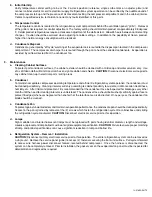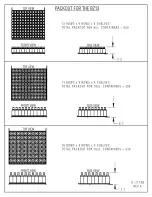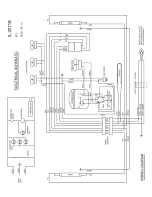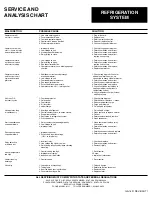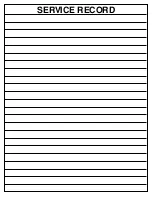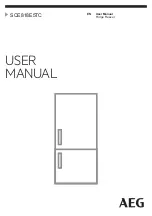
왎
REFRIGERATION SYSTEM
The Refrigeration System consists of a hermetically sealed compressor and finned evaporator and condenser.
왎
CONDENSER
The condenser has wide finned spaces which allow more air passage with less dirt or dust accumulation. The condenser
still requires periodic cleaning for maximum efficiency.
왎
CONDENSER FAN MOTOR
The condenser fan motor assembly is mounted between the condenser and compressor. Air is drawn through the
condenser, over the body of the compressor and then out the rear of the unit compartment.
The motor is wired to cycle with the compressor but will continue to operate should the compressor cut out on the overload.
(The motor is permanently lubricated; therefore, oiling is not required).
왎
DRIER
The drier is installed in the system just before the capillary tube. Its purpose is to trap minute particles of foreign material
and absorb any moisture in the system.
왎
LIQUID CONTROL AND HEAT EXCHANGE
Liquid refrigerant control to the evaporator of the system is accomplished by the use of a capillary tube or expansion valve.
This capillary tube or liquid line is soldered to the suction line to form a heat exchanger which subcools the liquid refrigerant to
maintain high efficiency within the system.
왎
REFRIGERATION SERVICE EVACUATION
Moisture in a refrigeration system is directly or indirectly the cause of more problems and complaints than all other factors
combined.
When large amounts are present, system freeze ups will occur. Even in minute amounts, moisture will combine with
refrigerants to form hydrochloric acid. The corrosive action of this acid forms sludge which will plug the lines and drier.
Since most field type vacuum pumps cannot pull a low enough vacuum to remove moisture from the system, it is
recommended that the system be triple evacuated, breaking each time with dry refrigerant nitrogen. Use care to purge air from
the charging hose when breaking the vacuum.
왎
CHARGING REFRIGERATION SYSTEM
Since capillary tube systems have small critical refrigerant charges, we recommend that a field charge either be weighed in
or put in from a portable charge board. After maximum vacuum has been obtained as detailed above, attach charging cylinder
to the suction line making sure to purge air from hose with refrigerant. With the unit running, allow refrigerant to run slowly into
the system until the desired charge is reached. When using Refrigerant Blends it is recommended to liquid charge into the
high side of the system with the initial charge and then any remaining charge can be put into the suction side; however, care
must be taken to meter the remaining amount into the low side so as not to cause excess liquid to go to the compressor
OVERCHARGE
UNDERCHARGE
When the cabinet has pulled down to operating
An undercharge or shortage of refrigerant will
temperature an indication of an overcharge is that
result in any or all of the following:
the suction line will be cooler than normal with the
1. Lower than normal head pressure.
compressor running. Running time will be higher
2. Lower than normal suction pressure.
than normal. Suction line will sweat or frost.
3. Excessive or continuous operation of compressor.
4. Higher than normal cabinet temperature.
Purge excessive refrigerant from the system very
carefully in small amounts waiting several minutes
for the system to balance.
FEDERAL LAW REQUIRES THAT REFRIGERANTS BE RECOVERED PRIOR TO SERVICING.
BEVERAGE-AIR
ILA-1591 REV B-SHT 2
REFRIGERATION
SYSTEM
SERVICE AND
ANALYSIS CHART



